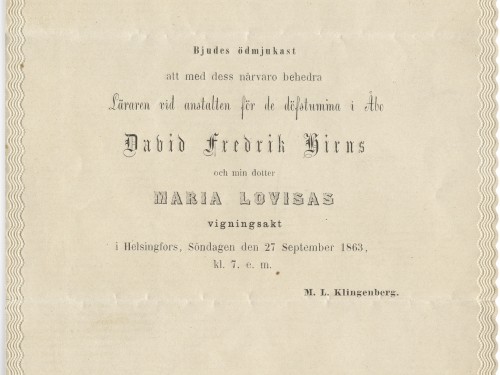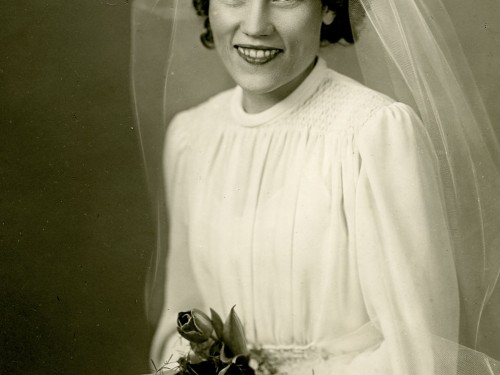Family life
In the 18th and 19th centuries in Sweden, which Finland was part of at the time, deaf people were permitted to marry, if they had a basic understanding of Christianity and the husband could provide for a family. Marriages between deaf people at that time have not been thoroughly studied and source material is likely Lue lisää
Read more
Tsar’s permission for marriage
It is generally thought that the first deaf people to marry in Finland were Carl Oscar Malm’s pupils Fritz Hirn and Maria Klingenberg. After finishing school, Fritz worked as a cartographer at a land survey office in Helsinki and later he founded a successful photography studio in the city. Fritz came to know Maria’s mother Lue lisää
Read more
Deaf families and marriages outside the community
In deaf history, it is common for a deaf person to have married and started a family with another deaf person. Typically, a spouse was found within the community. Often, marriages occurred between former schoolfriends, or then a spouse was found at deaf association meetings, other events for deaf people or through mutual deaf friends. Lue lisää
Read more
Marriage ban
In the late 19th century, the ideology of eugenics emerged in Finland, aimed at producing better-quality generations. The basic assumption within the movement was that the physical, mental, moral and social properties of offspring were determined by the laws of inheritance. Therefore, it was thought that by controlling procreation, the inheritance of undesired properties to Lue lisää
Read more
Empty nests
In the late 1920s and early 1930s, Finland prepared a sterilisation law based on the eugenics ideology, also. In the proposed law, people to be sterilised were divided into three groups, with deaf people placed in a group for which sterilisation was required for a marriage permit. Permitting the sterilisations of deaf people was justified Lue lisää
Read more
Law changes
Gradually, deaf people’s protests against the marriage law proved fruitful. In 1944, the marriage ban was restricted to marriages between people who had hereditary deafness even though the amendment did not specify how the non-hereditary nature of deafness should be demonstrated. Discussion on the matter continued in the Kuuromykkäin Lehti magazine. In the 1960s, criticism Lue lisää
Read more
Deaf and hearing children
In terms of identity, whether a deaf child is born to deaf or hearing parents makes a huge difference. Being born to a deaf family has always meant that the child shares a language with the parents. Such children grow up as members of the deaf community and their parents pass on sign language and Lue lisää
Read more
- occupations
-
personal history
-
Rurik Pitkänen

-
Torsten Rikström

-
Svante Lagergrén

-
Savisaari family

-
The Ritalas and the Talvias

-
The Stadius

-
Raija Nieminen

-
Elin Carlstedt

-
Oskar Wetzell

-
Martin Hellöre

-
Maria Lovisa Klingenberg

-
Julius Hirn

-
Jarmo Narmala

-
John Sundberg

-
Ida Mouton

-
Hulda Hakala

-
Elma Eklund

-
Fritz Hirn

-
Carl Henrik Alopaeus

-
Bruno Mouton

-
Aura Ahlbäck

-
Antti Jokelainen

-
Rurik Pitkänen
- organizations
-
deaf education
-
Deaf education

-
Early stages of deaf education

-
Argillander as a trailblazer

-
Malm’s school in Porvoo

-
A state school begins operations in Turku

-
More schools are founded

-
Goals of deaf education

-
The goals change

-
The era of oralism

-
The school system undergoes changes

-
Boarding schools

-
Sign language and bilingualism

-
Deaf education
- deaf awareness
- oralism
- family
- religious life